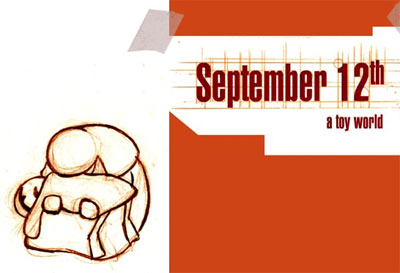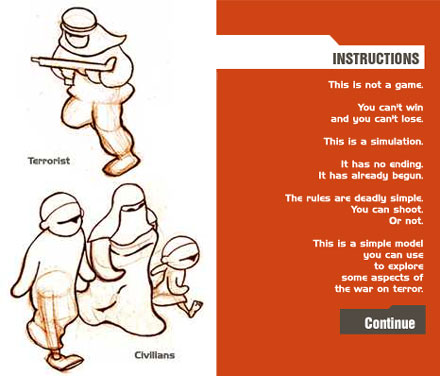After having time to play yesterday, I wanted to offer a few thoughts about September 12, the new game by newsgaming.com [I mentioned it earlier here (briefly linking it to Bookchin's version of The Intruder) - also discussed by GTA, GGA, and Jill]. The game requires the Macromedia Shockwave plug-in but is small enough to download in a reasonable amount of time. The introduction artwork features (presumably, based on garb, setting, and subject matter) a Muslim woman bent over and clutching a dead child in much the same way as Michelangelo's Pieta. The full title is listed as "September 12th: A Toy World," which brings to mind the doll-house effect - a mini-model experiment in which you tinker and experiment.

This introduction screen quickly switches over to the "instructions" screen [screenshot below], which details the recognizable icons in the game. Civilians are listed below - a man and woman walking with a child, all dressed in non-descript Muslim clothing. On the top, we see a running man holding an automatic weapon, underscored by the label Terrorist.

The rules are intriguing in themselves: This is "not a game," but a "simulation" without possible winners or losers. "It has no ending. It has already begun" reminds us that the title - September 12th - places us a day after the attack in New York, Pennsylvania, and DC. We are, then, the hand that holds the retaliatory trigger, the proverbial finger on the red button. "You can shoot. Or not."
The game play itself (or the simulation play?) is fairly straight forward - a town is full of the iconic characters introduced to us on the instructions screen. They run from building to building in a non-specific but obviously Middle Eastern city. The terrorists are easily pinpointed by their white head coverings. The player controls a crosshair, which they can use to deploy a missile that strikes approximately two seconds after mouse button is clicked. After the missile explodes, we have about a ten to fifteen second delay before the next missile can be deployed, a wise design decision that forces us to watch the missile land and the destruction it leaves in its wake.
If a civilian is hit (as they undoubtedly will be, based on the lead time of the missile and the speed of their walk) and another civilian walks by, the live civilian will stop and weep over the body of their fallen comrade. Make sure your speakers are on, because this sound is striking. The mourners will then, with a transformation that would stun Bruce Banner, stand and turn into terrorists.
The possible implications to a casual observer? Terrorists are recognizable. They only run with guns - they don't use them (even though the title reminds us of the terrorist attacks the day before, the terrorists depicted in the game are innocuous. They do not attack anything - they just run). American defense/aggression (whichever view you happen to take) only breeds more terrorists, rather than protecting against them. It also, in that any civilian can become a terrorist, homogenizes the fictional Arab city. Unintentionally, perhaps, the game seems to state that the only reaction to American weapons is to become a terrorist. Just as our options are limited to two (fight or not), so too are theirs.
Now, to be fair, I think the folks over at newsgaming are making a solid effort towards using games as a critical tool. I'm not arguing that the above is what the developers think - only what the game seems (to me anyway) to possibly imply. On the other hand, the instructions screen could be read as a subtle commentary on the media's portrayal, or perhaps America's presumption, that anyone who looks Arabic and holds a weapon is a terrorist. It may lead some to think about what may have happened had an alternate, non-military response be pursued in the wake of September 11th. Perhaps the name of the game, the echoing weeping, and the Pieta-style introductory image serve to remind people that there are days of grief aside from September 11th, and places of misery outside of the United States.
While I think that there might be room for these kinds of arguments and discussions, I worry that many who look at September 12th will only see what appears to be the games' seemingly implicit argument - that terrorists are easily identified by their garb and gun, that retaliation (or defense, again according to taste) will create more terrorists rather than fewer, and that isolationism is the only method of prevention (or perhaps just stasis - I did not leave the simulation running long enough to see if the numbers of terrorists moving about actually decreased if no bombs were dropped). In other words, the complexity of the perspective might get lost in the simplicity of game play.
In any case, "September 12th: A Toy World" is certainly worth checking out, if only so you can add to the conversation, which is the developer’s clearly stated - and admirable - intention.
Good thoughts, Jason. What do you make of the landscape atop which the city is built, which seems to be composed of the pages of a printed book?
Posted by: Matt K. at October 1, 2003 8:51 PM | Permalink to CommentWhat a great post, Jason! It's wonderful to read such a careful analysis!
Matt, I hadn't noticed the print "ground" in the game, so I went back and had another look - I think perhaps it's newspaper? It certainly looks like print, but the columns are more like newspaper than book pages. That's a really interesting concept, too: a fictional and heavily stylised simulation of an arab town grown out of a page of a newspaper. Suitable for a site called Newsgaming. But it adds another level of unreality to the mix, doesn't it?
Posted by: Jill at October 2, 2003 8:05 AM | Permalink to CommentJill's right, I think - newsprint of some sort (my home network was down this morning, so I couldn't check... and I think I'll avoid setting off a number of flags w/in the Fed government by checking from work!) - which does make one think that perhaps the game is more a critique of reporting rather than policy? But then, it's terribly hard to separate those two things nowadays, isn’t it?
It's interesting though - the images and setup are so much more subtle than the game play itself. I can mentally go back and forth over possible meanings behind the rich images (the artwork is really well done) - but as soon as game begins I find myself distracted. That is, I start paying attention to the implications of the coding - and the choices therein - rather than the setup (artwork, rules, etc.), and find it much less nuanced and less interesting (and increasingly problematic). I'm not sure that I've figured out why that is...
With Bookchin’s The Intruder, for example, playing the game puts you in a subject position that functions as accomplice to the brothers’ misogyny (since you are the one who harms the female avatar you play, in order to continue the story) while also making you critically aware - *through the game play* - of that process. I’m not sure that September 12th provides me with that same depth … did it for either of you?
Reminds me of a medieval manuscript more than newsprint: in places the lettering, if lettering it is, looks almost gothic. But I wonder if it's really just supposed to represent furrowed or textured (as opposed to textual) ground or something like that ...
Posted by: Matt K. at October 2, 2003 11:26 AM | Permalink to CommentYou're thoughtful reflections are so much more generous than mine, Jason. After spending ten minutes with September 12, I exited in boredom. "Simplistically didactic" is my two word review--with the accent on "didactic."
Posted by: kari at October 3, 2003 10:36 AM | Permalink to CommentKari & Jason
Re the gameplay
Is there a Renga in the making? I mean if the Macromedia Director files that were used to create the Shockwave movie were made available to a community of Lingo programers would not the very simplicity of the gameplay invite the creation of variations? Complexity could be added with a handle that depending on properties and events would lead to different types of morphing.
I think what may be on offer here is didactic simplicity and not simple didacticism. The game storyline so far provides for the morphing into terrorist-like figures. There is room for the introduction of play lines that would centre on the morphing of the terrorist-like figures themselves. That the game coders chose not to introduce a time-based decommissioning and have the terrorist-like figures remorph into the other figures that populated the gamescape is telling. (Even it this were not a conscious choice, the sophistication of the positioning of the game player, the suggestiveness of the artwork and the limited options programmed into the movie described by Jason point to a textual system where reversal and further morphing are close to the foreground. [Macromedia authoring software uses cinematic metaphors and incorporates ways for easily reversing a sequence.]
The current version of the game is apocalyptic. I like Kari find such scenarios simplisitic. In rhetorical terms appeals to a closed universe and no exit outcomes trade on fear and guilt. Stepping away from the game itself and examing the discourse that shapes the historical understanding of the attacks on the World Trade Centre, I am struck by how this game resonnates with apocalyptics rehersed by the application of the term "Ground Zero" to the site of the attacks on the World Trade Center: oddly globalizing the events and yet nationalizing them by erasure of the imagery of commerce and interchange that is ferried by the site-specific name. A toy world is one where history is displaced. Whose toy? Time to delve into the code and rewrite the game rules. Or at least expose them. There is a WTC interactive piece waiting to be created. Indeed a plurality of them. And some of those, it is hoped, will not be written in an apocalyptic mode.
And thanks to Kari and Jason for having pointed to this dimension of that particular toy world.
For more on the loss of specificity as a term migrates) in Word Pirate entry and comments about the term Ground Zero:
http://www.wordpirates.com/index.cgi/G/ground_zero.individual
For more on how "Globalization also entails that what were problems within national boundaries gradually became global." See Walid Hamarneh who in "That Tempestuous Loveliness of Terror" invokes the distinction between two types of experience Erlebnis and Erfahrung to reflect upon how trauma turns to terror. "The fear resulting from terror in life and life in terror turns terror from the sphere of the extraordinary, the abnormal, the rare, into the sphere of the daily, the always expected, the norm."
http://collection.nlc-bnc.ca/100/201/300/literary_research-ef/n28-n36/no36/articles/ForumHamarneh.htm
"In rhetorical terms appeals to a closed universe and no exit outcomes trade on fear and guilt."
Well said.
Thanks to both of you for comments. I'd add further thoughts, but I'm afraid a wonderful weekend with family has left me happily exhausted.
Francois - I'm not sure if this [ http://www.kinematic.org/ ] is the "WTC interactive piece waiting to be created" ... but it's a disturbing companion to newsgamings' Sept. 12.